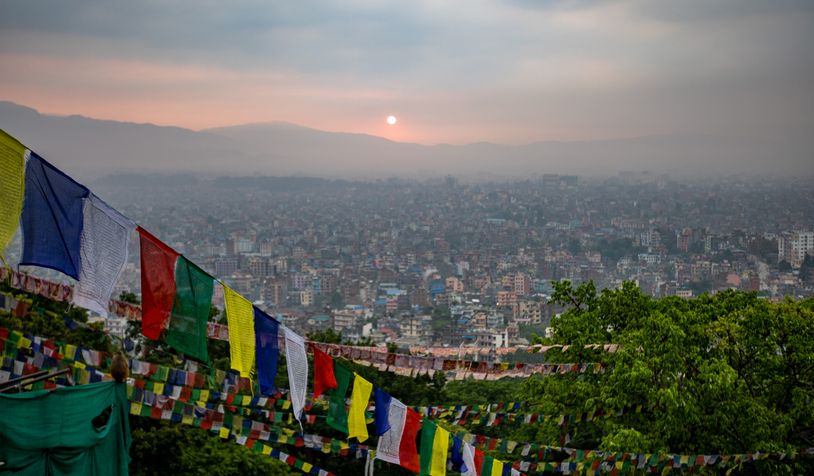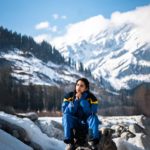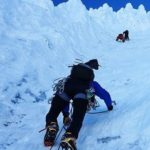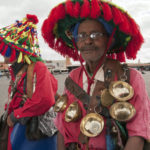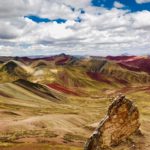Everest Base Camp Trek
Walk among giants, test your limits, discover your strength.
Base Camp. Two little syllables that conjure up dreams as immense and powerful as the Himalayan Mountains themselves. This 15-day trekking tour is your chance to make these dreams come true, to challenge yourself and discover both the majesty of the mountains and your own potential. Walk among giants of nature and revel in the sense of freedom that comes from leaving Wi-Fi and Netflix behind for card games in tiny teahouses, learning about Sherpa life and watching the sunrise over Everest. Plus, our commitment to the rights and fair treatment of porters and trekking guides means you can rest assured knowing you’re doing the trek of a lifetime the ethical way.
ALTERNATE ITINERARY:
In case of weather conditions leading to cancellations or delays in included flights, this trip will operate on an alternate itinerary. Please see day 1 of the itinerary for more details.
Start: Kathmandu, Nepal
Finish: Kathmandu, Nepal
Destination: Everest Base Camp, Nepal
Theme: Trekking
Ages: Min 12
Group size: Avg 10
Why You'll Love This Adventure?
- In addition to immense rugged mountains, witness everything from still alpine lakes and glacial plains to frothy rivers and valleys covered in pink blossoms, depending on the season.
- A trek like this is the bonding experience of a lifetime and the genuine comradery formed between members of your small group will stay with your forever.
- Get your first glimpses of the mighty Himalayan range on the included flight from Kathmandu to Lukla – the famous airport in the sky.
- Hike with an experienced and passionate English-speaking local leader as well as a team of guides and porters who will introduce you to rich Sherpa culture.
- We partner with local mountaineering and porter welfare programs, so you can trek easier knowing that while our porters are taking care of you, there’s someone looking out for them.
Is this experience right for you?
- The weather can be unpredictable in the Himalayas and every year a significant number of trips have flights to or from Lukla delayed or cancelled due to weather conditions. See day 1 of the itinerary for the alternative plans should this happen on your trip.
- Hiking the Himalayas is no walk in the park. But seriously, this trip includes 12 days of trekking for up to eight hours per day, reaching altitudes of over 5500 metres. Depending on the time of year, the weather can be harsh. Ask anyone who has done it and they will say the rewards are worth it, but we can’t stress enough that you must be in excellent health to participate. Think you’re up for it?
- The trekking lodges, known as teahouses, that we stay in on the trek are very simple with only basic facilities.
- The scenery and conditions vary between seasons. Please carefully consider the time of the year you wish to trek in.
- The Everest Base Camp trek is a very popular route and you will encounter many other trekkers and groups on the trail and at the teahouses. If you are after a trek that sees less travelers and spends more time trekking through communities rather than on a more established route, let us know and we have a variety of alternate itineraries.
- This trip includes one or more overnight stays over 3500 metres (11500 ft) where there is a genuine risk of being affected by Acute Mountain Sickness (AMS). If left untreated AMS can be life-threatening. While the vast majority will only feel discomfort, it is not uncommon for a small number of people to need extra care which will be provided by our leaders and local staff. All our trips that spend time at high altitude follow our standard altitude safety measures. A number of medical conditions and medications can also reduce your body’s ability to acclimatise, and thus will affect your performance at altitude and make you more susceptible to AMS. If you are worried about any pre-existing condition (e.g. heart problems), or unsure of your physical ability, you must seek medical advice prior to booking. You may also wish to discuss medication such as Diamox that may help aid acclimatization. Contact us for more information on AMS.
Gallery
Itinerary
Day 1: Kathmandu
Namaste! Welcome to Kathmandu, the colourful capital of Nepal where ornately carved balconies mingle with beautiful shrines and temples. Your adventure begins with a welcome meeting at 2 pm today. If you arrive with time to spare, maybe check out the storied stupas and pagodas of Swayambhunath (Monkey Temple) or take a walk around the local Durbar Square. If you’ve got limited time in the city, consider an immersive Urban Adventure like Cook in Kathmandu, a community farm-to-table cooking class with the Seven Women social enterprise.
ALTERNATIVE ITINERARY DUE TO FLIGHT CANCELLATIONS:
Weather conditions in the Himalayas can change rapidly, which can result in the need for changes to be made to our intended itineraries. Flights throughout Nepal – particularly in high mountain areas – are often delayed or cancelled due to poor weather conditions. Flights between Kathmandu and Lukla are particularly prone to these delays which has the potential to vary the itinerary of our tour departures. Our contingency plans in case of bad weather preventing the fixed wing aircraft flight from Kathmandu to Lukla are as follows:
Day 2 – We will attempt to board our booked fixed-wing plane as per the itinerary. If this flight is cancelled, we will return to our hotel in Kathmandu for an additional night.
Day 3 – We will again attempt to board our booked fixed-wing plane. If this flight is cancelled we will endeavour to charter a helicopter to transport the group, provided helicopters are available and weather does not prevent them from flying to Lukla.
Travellers will need to use their emergency fund to cover the cost of the chartered helicopter. The exact cost will depend on how many travellers are in your group and could be up to US 500. If we reach Lukla on day 3 by either fixed wing aircraft or helicopter we will then follow the same itinerary to Everest Base Camp but descend over one less day in order to take our return flight from Lukla on day 14.
Day 4 – If both fixed-wing planes and helicopters are unable to reach Lukla on the morning of day 3, then on day 4 we will travel by road to Phaplu (an approximately 9-hour drive by private vehicle) and then trek to Tengboche on the Everest Base Camp route via Lukla. While we will not be able to reach Base Camp itself on this altered itinerary, but our travellers have still found it a highly enjoyable trek with superb views of the ranges and Everest itself.
We also advise allowing a few extra days in Kathmandu at the end of your trip should your return flights from Lukla be delayed due to weather conditions.
Accommodation
- Guesthouse (1 night)
Day 2: Phakding (2610m)
Sitting at 8848 m Mt Everest, the highest peak in the world, is one of the greatest trekking destinations. Locally known as Sagarmatha, the mountain has long been revered as the home of the gods. First conquered by Tenzing Norgay and Sir Edmund Hillary in 1953, Everest has traditionally been the ultimate goal for mountaineers. On this trip you will take on the challenge of reaching the mountaineer’s base camp and gain an insight into the world famous Sherpa culture. You will cross glaciers and broad plains, traverse valleys and climb high passes to reach the picturesque Everest Base Camp. Our accommodation comprises small, basic teahouses along the track. These basic but cosy remote houses are operated by the mountain Nepalese to cater for trekkers and also offer simple yet filling and delicious meals to sustain our efforts. This is a challenging trip and involves difficult trekking at high altitudes but the whole experience is simply awe-inspiring!
Today we have a very early (approx. 6.30 am) flight from Kathmandu to Lukla (45 minutes). If the weather is good, the views of the Himalayas from the small plane are amazing! After breakfast in Lukla (2840 m), a short safety talk and an introduction to our porters, we gear up and commence our trek. Today is a fairly gentle introduction, following the milk-white Dudh Kosi River approximately three-hours to Phakding (2610 m).
Overall altitude gain today between places we sleep is -190m.
Accommodation
- Teahouse (1 night)
Day 3: Namche Bazaar (3440m)
Accommodation
- Teahouse (1 night)
Day 4: Namche Bazaar (3440m)
Accommodation
- Teahouse (1 night)
Day 5: Phortse Gaon (3810m)
Overall altitude gain between places we sleep is 370m.
Accommodation
- Teahouse (1 night)
Day 6: Dingboche (4360m)
Overall altitude gain between places we sleep is 600m.
Accommodation
- Teahouse (1 night)
Day 7: Dingboche (4410m)
Accommodation
- Teahouse (1 night)
Day 8: Lobuche (4900m)
The trek to Lobuche is about six hours and covers 7 km, bringing us close to our ultimate goal!
Overall altitude gain between places we sleep is 490m.
Accommodation
- Teahouse (1 night)
Day 9: Lobuche (4900m)
This is the big one, the day of Everest Base Camp. From Lobuche, follow the broad valley that runs parallel to Khumbu Glacier, with a gradual ascent enabling you to build the slow, steady rhythm required when walking at high altitude. When you reach the moraines of Changri Nup Glacier, you will make a series of small ascents and descents over a rocky trail lined with cairns that eventually leads to the surprising glacial sands of Gorak Shep (5160m) – reached after about three hours of walking. Now’s the time to grab a quick bite, gear up appropriately, and then head off towards Everest Base Camp. The trek to the base camp can be achieved in around three hours, and if trekking in the popular climbing period of March to May, you will almost certainly encounter yaks and porters supplying food and equipment to expeditions here. From Everest Base Camp you will not get views of Mount Everest, but you are able to see glorious glaciers, lakes, caves, and the notorious Everest Ice Fall that flows from the Western Cwm. It’s regarded as technically the hardest and most dangerous section of the mountain. The return journey from the Base Camp to Gorak Shep takes the same amount of time. You will have an early dinner so that you are able to get up early the next day for awe-inspiring views of the Himalayan giants from Kala Patar.
Notes: Trekking time approximately 3 hours to Gorak Shep (5160 m) and approximately 5 hours round trip to Everest Base Camp. Overall altitude gain between places we sleep is 240m.
Accommodation
- Teahouse (1 night)
Day 10: Kala Plattar - Pheriche or Orsho
Today we witness some of the Himalayas most recognisable sights. We make an early start to avoid the early morning clouds and trek to Kala Pattar (5545 m) to witness the best views of Everest.Don’t be surprised if you get a little tear in your eye when you soak up the views of Everest. Embrace that emotion and spend as long as you like here to savour this extra special moment. To get there from the lodge the ascent is quite steep, so start very slowly and try to ascend at a steady rhythmic pace. Kala Patar is the rocky hilltop below Pumori. It’s a tough walk because of the altitude, but the view from the top will surpass your wildest imagination. It will probably take a good hour and a half to reach the summit from Gorak Shep, although lower viewpoints can provide views that are almost as good. Pumori, Nuptse, Changtse, Ama Dablam, Taweche, Kantega and Everest – they’re all here. About three kilometres away and some 200 metres below, the area of the Everest Base Camp can be seen in a bowl at the bottom of the Khumbu Ice Fall. Then it’s all downhill from here – the descent to Gorak Shep is easy and when you arrive back at the lodge you will have a quick drink and head off to the rooms to pack your kit bags while breakfast is being prepared. After breakfast you will set off to Lobuche and Thugla, where you will stop for lunch. Then you’ll cross the Khumbu Khola and head down the valley below Cholatse to Pheriche, where you will stop for the night.
It’s a tough walking day (approx. 8 hours), and depending on how the group feels, your leader will decide where you spend the night.
Accommodation
- Teahouse (1 night)
Day 11: Tengboche (3840m)
Trek to Tengboche is approx. 4 hours).
Accommodation
- Teahouse (1 night)
Day 12: Monjo (2860 m)
Accommodation
- Teahouse (1 night)
Day 13: Lukla
Accommodation
- Teahouse (1 night)
Day 14: Kathmandu
Accommodation
- Kathmandu Guesthouse or similar (1 night)
Special Information
If there is bad weather or low cloud conditions our flight back to Kathmandu may not go, giving us an extra day in Lukla to relax or do a day walk. In this case, we will return to Kathmandu by late morning on day 15 and the trip will end with an arrival transfer back to our hotel.
Please note that in peak travel times domestic flights to/from Kathmandu may arrive/depart from Ramechhap (also known as Manthali) Airport. The airport is located 130km (approx. 4-5 hours drive) from Kathmandu.
Day 15: Kathmandu
Day 15 is departure day and we say ‘Namaste’ for memories that will last a lifetime. There are no activities planned for today and you are able to depart the hotel at any time. Check out time from the hotel is at 12 noon. If you are departing later, you can arrange luggage storage at the hotel.
At the end of your tour please consider donating to the KEEP Porters Clothing Bank. As you will have come to realise on your tour, porters play a vital role in the tourism industry enabling tourists to visit Nepal’s most picturesque and difficult terrain. The majority are subsistence farmers who travel from lower areas of Nepal to the higher elevated trekking routes to find employment. Contrary to the belief that porters are well-adjusted to the cold and altitude of the Himalayas, every year many porters suffer from a variety of illnesses such as altitude sickness, snow blindness, hypothermia and frostbite and some even die as a result. The Clothing Bank was set up in 2009 to provide ill-prepared porters with better clothing suitable for trekking in a mountain environment and reduce the number of unnecessary illnesses and fatalities which occur each year.
Usually donations of used jackets and trousers/pants from Westerners do not fit Nepali porters who tend to be smaller. However donations of other clothing items such as socks, boots, sunglasses, warm gloves and sleeping bags are always welcome. Your leader can ensure that your donation is passed on.
Inclusions
Meals
No meals are included on this tour
Transport
Private vehicle, Plane
Accommodation
Hotel/Guesthouse (2 nights), Teahouse (12 nights)
Included activities
- English-speaking local guide and assistants for the trek
- Porters included on the trek
- Trekking to Everest Base Camp
- Internal flights
- All transport between destinations and to/from included activities




